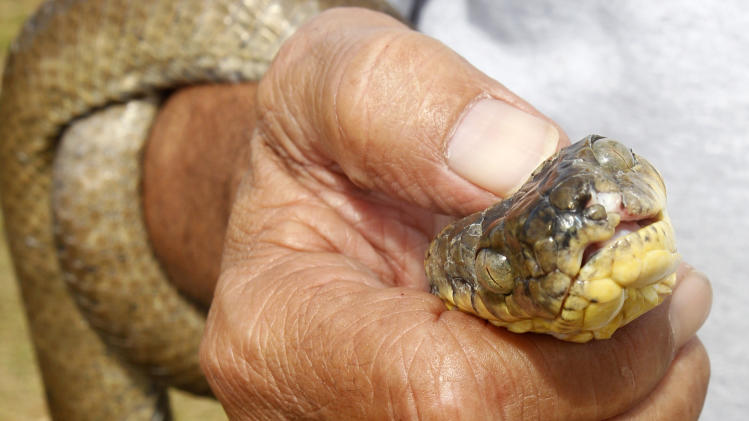Operation Dead-Mouse Drop
The U.S. government is planning to drop toxic mice from helicopters to battle the snakes, an invasive species that has decimated Guam's native bird population and could cause billions of dollars of damage if allowed to spread to Hawaii. (Eric Talmadge/AP)
A group of 2,000 dead mice equipped with cardboard parachutes have been airdropped over a United States Air Force base in Guam in order to poison brown tree snakes.
It may sound like the plot to an animated movie starring the vocal talents of Gilbert Godfried, but we assure you this is actually happening.
NBC News reports that the dead mice were pumped full of acetaminophen, the active ingredient in Tylenol. The hope is that the snakes, which are invasive to the area and cause harm to exotic native birds and the island's power grid, will be drawn to the toxic rodents, eat them, and then croak. Other animals face minimal risk, reports the Air Force Times.
Dan Vice, the Agriculture Department's assistant supervisory wildlife biologist for Guam, told KUAM that the mice are dropped in a time sequence from low-flying helicopters. Each rodent is strung up to a tiny parachute made of cardboard and tissue paper.
Via NBC News:
So how will workers know if the plan is working? After all, it's not like the mice can radio back to base. Or can they? The workers behind the plan told NBC News that some of the mice will have data-transmitting via radios.
It may sound like the plot to an animated movie starring the vocal talents of Gilbert Godfried, but we assure you this is actually happening.
NBC News reports that the dead mice were pumped full of acetaminophen, the active ingredient in Tylenol. The hope is that the snakes, which are invasive to the area and cause harm to exotic native birds and the island's power grid, will be drawn to the toxic rodents, eat them, and then croak. Other animals face minimal risk, reports the Air Force Times.
Dan Vice, the Agriculture Department's assistant supervisory wildlife biologist for Guam, told KUAM that the mice are dropped in a time sequence from low-flying helicopters. Each rodent is strung up to a tiny parachute made of cardboard and tissue paper.
Via NBC News:
"The cardboard is heavier than the tissue paper and opens up in an inverted horseshoe," Vice said. "It then floats down and ultimately hangs up in the forest canopy. Once it's hung in the forest canopy, snakes have an opportunity to consume the bait."
The mission is part of an $8 million program from the Interior and Defense departments, Phys.org reports. If the mission is successful, experts may expand it to other parts of Guam. In other words, maybe a sequel is forthcoming.

No comments:
Post a Comment